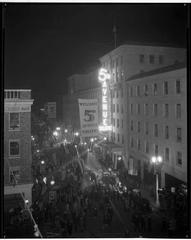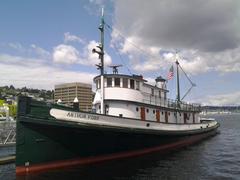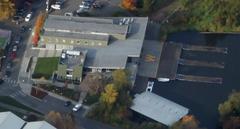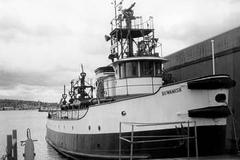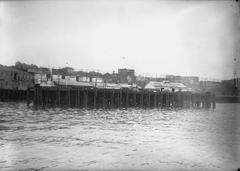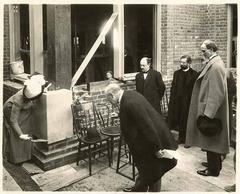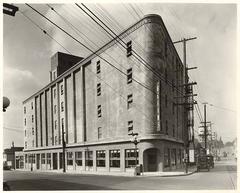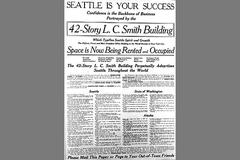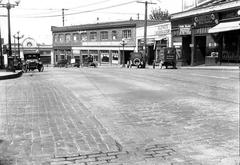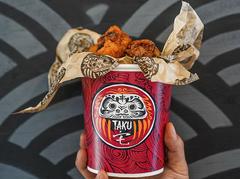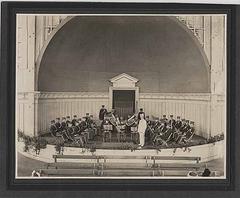The Mitt Seattle: Visiting Hours, Tickets, and Historical Sites Guide
Date: 04/07/2025
Introduction
The Mitt, an iconic bronze sculpture by Gerard “Gerry” Tsutakawa, is a beloved symbol of Seattle’s vibrant baseball culture and commitment to public art. Located outside the left field entrance of T-Mobile Park, The Mitt is more than a landmark—it’s a tactile, interactive invitation to engage with Seattle’s community spirit, history, and creativity. This comprehensive guide covers everything you need to know about visiting The Mitt: its history, cultural significance, practical visitor tips, accessibility, nearby attractions, and the story behind its creation.
(MLB.com) (Woodside Braseth Gallery) (Seattle.gov)
Table of Contents
- Introduction
- History and Commissioning of The Mitt
- Artistic Context and Design
- Visiting The Mitt: Hours, Tickets, and Accessibility
- Travel Tips & Nearby Attractions
- The Mitt in Seattle’s Public Art Movement
- The Tsutakawa Legacy
- Reception and Cultural Impact
- Maintenance and Preservation
- FAQs
- Visuals and Media
- Conclusion and Recommendations
- References
History and Commissioning of The Mitt
Commissioned in 1999 as part of the public art initiative for Seattle’s new baseball stadium (then Safeco Field, now T-Mobile Park), The Mitt was created by local artist Gerard Tsutakawa. The Mariners and the city of Seattle sought a landmark that would reflect both the spirit of baseball and Seattle’s tradition of accessible, interactive public art, in alignment with the city’s pioneering 1% for Art program (KUOW, Seattle.gov).
Tsutakawa, son of renowned sculptor George Tsutakawa, envisioned The Mitt as a playful, approachable piece—one meant to be touched, climbed, and photographed. Its oversized, abstract form encourages physical interaction, setting it apart from traditional, hands-off public art. The Mitt’s circular opening in the palm offers both literal and symbolic interpretations, from a baseball caught mid-glove to a portal inviting imagination (Wikipedia, Land of the Bigs).
Artistic Context and Design
Inspired by Tsutakawa’s Japanese heritage and the organic forms of the Pacific Northwest, The Mitt stands roughly 9 feet tall and 12–14 feet wide. The smooth, curved bronze invites touch, while its abstracted design leaves interpretation open to each visitor. This interactive philosophy aligns with Seattle’s ethos of public art as an everyday, community-centered experience (Asian Lifestyle Design, Seattle.gov).
Visiting The Mitt: Hours, Tickets, and Accessibility
- Location: Outside T-Mobile Park’s left field entrance, 1250 1st Ave S, Seattle, WA 98134.
- Visiting Hours: The Mitt is accessible to the public daily, from dawn until dusk, year-round. Access is free and does not require a Mariners game ticket.
- Tickets: No tickets are needed to visit The Mitt. Mariners game or ballpark tours require separate tickets (Mariners Tickets).
- Accessibility: The plaza is wheelchair-accessible, with paved and ramped walkways for easy navigation.
Travel Tips & Nearby Attractions
- Getting There: The Stadium Station on the Link Light Rail and several King County Metro bus routes serve the area. Parking is available but limited, especially on event days; public transit or ride-sharing is recommended.
- Nearby Attractions: Pioneer Square, the Seattle waterfront, the Museum of Pop Culture, and the International District are all within easy reach. The stadium area also features other public art installations and statues of Mariners legends.
- Best Times to Visit: Early morning or late afternoon on non-event days offers the best light for photography and fewer crowds.
(Ballpark Ratings) (Sportsnaut) (Baseball Biographies Travel Guide)
The Mitt in Seattle’s Public Art Movement
Seattle’s 1% for Art ordinance, established in 1973, channels a portion of eligible public funds into the creation and maintenance of public art. This policy has resulted in a prolific civic art collection, with The Mitt serving as a flagship example. The selection of Tsutakawa’s design reflects the city’s commitment to engaging, community-focused art that shapes the character of public spaces (Seattle.gov).
The Tsutakawa Legacy
The Mitt is a continuation of the Tsutakawa family’s artistic contribution to Seattle. George Tsutakawa, Gerry’s father, created over 70 fountains across the Pacific Northwest. Gerry’s distinctive style—playful, interactive, and approachable—has earned him recognition in his own right, with The Mitt cementing his place in the city’s cultural landscape (South Seattle Emerald).
Reception and Cultural Impact
Since its unveiling, The Mitt has become a cherished gathering point and photo backdrop for locals and visitors. Its surface, polished by years of hands and playful climbing, is a testament to its popularity and Tsutakawa’s vision of accessible art. The Mitt is regularly included in walking tours, school visits, and Mariners game day rituals, embodying Seattle’s inclusive community ethos (Wikipedia, KUOW).
Maintenance and Preservation
The Mitt is maintained as part of Seattle’s public art collection by the Office of Arts & Culture. Regular cleaning and annual polishing ensure its longevity and appearance, with patina developing naturally on the bronze except where it’s most frequently touched (Wikipedia).
Frequently Asked Questions (FAQ)
Is there an entrance fee to visit The Mitt?
No, The Mitt is outside T-Mobile Park and always free to visit.
What are the best times for photos?
Early mornings or late afternoons on non-game days offer good light and fewer crowds.
Is The Mitt accessible for wheelchairs and strollers?
Yes, the plaza is flat and fully accessible.
Can I touch or climb on The Mitt?
Yes, interaction is encouraged—just be respectful of others.
Are there tours that include The Mitt?
T-Mobile Park stadium tours and some Seattle walking tours include The Mitt; check with local providers for details.
Visuals and Media
Visitors are encouraged to photograph The Mitt from various angles. Use descriptive alt text for images, such as “The Mitt bronze baseball glove sculpture outside T-Mobile Park, Seattle,” to improve accessibility and SEO.
Conclusion and Recommendations
The Mitt stands as a testament to Seattle’s fusion of sports, public art, and community values. Freely accessible, inclusive, and engaging for all ages, it’s a must-see whether you’re attending a Mariners game, exploring Seattle’s SoDo district, or seeking out the city’s top public art. For real-time updates, guided tours, and more travel tips, download the Audiala app and follow local channels.
References
- Discover The Mitt: Seattle’s Iconic Baseball Sculpture – Visiting Hours, Tickets, and Visitor Guide (MLB.com)
- The Mitt Sculpture at T-Mobile Park: Visiting Hours, Tickets, and Seattle Historical Sites (Woodside Braseth Gallery)
- Seattle’s Art Scene – Museums & Public Installations (Seattle Wire)
- Official Seattle Visitors’ Guide: The Mitt (Official Seattle Visitors’ Guide)
- Do you know the family story behind Seattle’s beloved baseball mitt? (KUOW)
- Public Art Program (Seattle.gov)
- Gerard Tsutakawa artist profile (Woodside Braseth Gallery)
- The Mitt at T-Mobile Park (Wikipedia)
- The Mitt at Land of the Bigs (Land of the Bigs)
- Asian Lifestyle Design: The Mitt (Asian Lifestyle Design)
- Ballpark Ratings: T-Mobile Park Art (Ballpark Ratings)
- South Seattle Emerald: Tsutakawa Legacy (South Seattle Emerald)
- Sportsnaut: T-Mobile Park Visitor Info (Sportsnaut)
- Baseball Biographies Travel Guide (Baseball Biographies Travel Guide)
